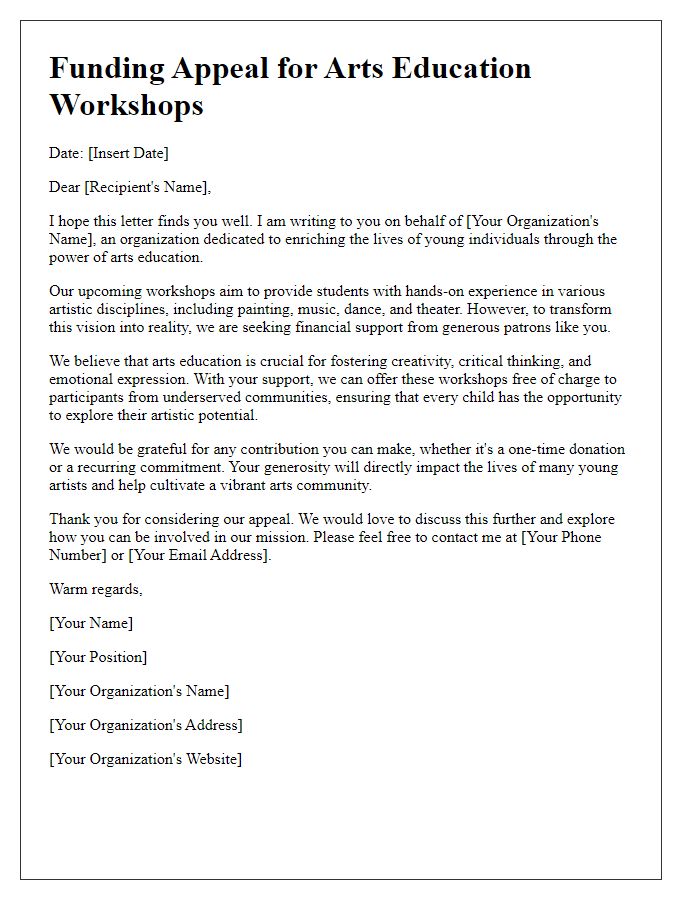Are you passionate about supporting the arts and culture in your community? Crafting a well-structured letter can be the key to securing funding that helps nurture creativity and brings vibrant cultural experiences to life. In this article, we'll explore essential components of a successful funding request, including how to articulate your vision and demonstrate the impact of your project. So, if you're ready to dive in and transform your ideas into actionable plans, keep reading!

Purpose and significance of the project
The "Community Art Revitalization" project aims to transform underutilized public spaces in downtown Springfield, Massachusetts, into vibrant art installations that reflect local culture and history. This initiative focuses on engaging artists from diverse backgrounds, promoting inclusivity, and fostering community pride. The project will create opportunities for public workshops and collaborations with local schools, enhancing educational experiences related to arts and culture. Historic sites such as the ongoing restoration of the Springfield Armory will serve as sources of inspiration, ensuring that the project's significance extends beyond aesthetics, cultivating a shared identity and fostering social cohesion among residents. Ultimately, the revitalization will contribute to tourism, stimulating local businesses and enriching the cultural fabric of the community.
Detailed budget overview
The detailed budget overview for funding arts and culture initiatives outlines a comprehensive financial plan essential for project success. The overall budget totals $50,000, allocated across multiple categories. Personnel expenses, including artist fees and administrative salaries, amount to $20,000, ensuring fair compensation for talent and staff supporting the project. Facility costs at the downtown community center, estimated at $10,000, cover rental fees and utilities for the duration of the exhibition. Marketing and promotional efforts, budgeted at $8,000, will enhance community engagement through social media campaigns, flyers distributed throughout the local area, and a press release targeting regional media outlets. Additionally, materials and supplies necessary for workshops and events total $7,000, encompassing art supplies, technology equipment, and other resources essential for participant engagement. Finally, a contingency fund of $5,000 accounts for unexpected costs, ensuring financial stability throughout the project lifecycle. This budget highlights our commitment to advancing arts and culture within the community while maximizing the impact of funding received.
Target audience and community impact
The proposed arts and culture funding initiative aims to enhance the creative landscape of underserved communities, such as the South Side of Chicago. By allocating $500,000 for public art installations and cultural programming, this initiative seeks to engage local artists and craftsmen in meaningful projects that resonate with community history. Interactive workshops will target over 1,000 residents, fostering artistic expression and cultural exchange. Special events, such as the annual South Side Arts Festival, will showcase diverse talents and attract visitors, promoting economic revitalization in the neighborhood. The impact extends beyond aesthetics, as this initiative nurtures community pride, nurtures local identity, and reinforces social cohesion among residents from various backgrounds. This investment in arts and culture will not only uplift the community economically but also enrich it socially and culturally, creating lasting benefits for future generations.
Experience and qualifications of the team
The arts and culture funding application team possesses extensive experience, with a collective background spanning over 25 years across various disciplines. This multidisciplinary team includes experienced project managers, cultural strategists, and seasoned artists with notable contributions to regional projects. Key team members have led successful initiatives in art exhibitions, community outreach programs, and cultural festivals, such as the acclaimed Edinburgh Festival Fringe, which attracts over 2 million visitors annually. Additionally, the team includes grant writers with a proven track record of securing funding from prestigious organizations, including the National Endowment for the Arts (NEA) and the Arts Council England. Regular collaborations with local museums, theaters, and educational institutions enhance the team's capability to engage diverse audiences effectively. Each member brings unique insights gained from previous roles, ensuring a comprehensive approach to arts and culture project development.
Long-term benefits and sustainability plan
Funding for arts and culture projects often focuses on long-term benefits and sustainability to ensure continued impact within communities. Comprehensive planning is essential. Clear frameworks require outlined goals, strategies, and measurable outcomes. For instance, local art programs foster cultural engagement, support regional artists, and stimulate local economies, generating revenue. Sustainable practices may include environmental considerations, such as reducing waste through eco-friendly materials and processes. Community partnerships with schools and non-profit organizations enhance accessibility and education for diverse audiences. Continued engagement through workshops, exhibitions, and community events solidifies a vibrant cultural landscape, ensuring the project's relevance and ongoing support. Evaluating success through regular assessments allows adaptations to meet community needs effectively.
Letter Template For Arts And Culture Funding Samples
Letter template of collaborative grant request for multi-artist projects













Comments